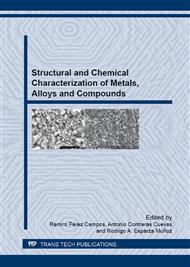[1]
B. Panella, M. Hirscher and S. Roth, Hydrogen adsorption in different carbon nanostructures, Carbon 43 (2005) 2209-2214.
DOI: 10.1016/j.carbon.2005.03.037
Google Scholar
[2]
X. Hu, M. Trudeau and D.M. Antonelli, Hydrogen storage in microporous titanium oxides reduced by early transition metal organometallic sandwich compounds, Chem. Mater 19 (2007) 1388-1395.
DOI: 10.1021/cm062933l
Google Scholar
[3]
T. Spassov, V. Rangelova, H. Chanev, S. Stoyanov and O. Petrov, Synthesis and hydrogen adsorption in Cu-based coordination framework materials, Scripta Materialia 58 (2008) 118-121.
DOI: 10.1016/j.scriptamat.2007.09.024
Google Scholar
[4]
S. Proch, R. Kempe, C. Kern, A. Jess, L. Seyfarth and J. Senker, Pt@MOF-177: Synthesis, room-temperature hydrogen storage and oxidation catalysis, Chem. Eur. J. 14 (2008) 8204-8212.
DOI: 10.1002/chem.200801043
Google Scholar
[5]
A.R. Biris, D. Lupu, E. Dervishi, Z. Li, V. Saini, D. Saini, S. Trigwell, M.K. Mazumder, R. Sharma and A.S. Biris, Hydrogen storage in carbon-based nanostructured materials hydrogen storage in carbon-based nanostructured materials, Particulat. Sci. Tech. 26 (2008).
DOI: 10.1080/02726350802084051
Google Scholar
[6]
S.C. Amendola, S.L. Sharp-Goldman, M.S. Janjua, M.T. Kelly, P.J. Petillo and M. Binder, An ultrasafe hydrogen generator: aqueous, alkaline borohydride solutions and Ru catalyst, J. Power Sources 85 (2000) 186-189.
DOI: 10.1016/s0378-7753(99)00301-8
Google Scholar
[7]
Z.P. Li, B.H. Liu, K. Arai, N. Morigazaki and S. Suda, Protide compounds in hydrogen storage systems, J. Alloys Compd. 356-357 (2003) 469-474.
DOI: 10.1016/s0925-8388(02)01241-0
Google Scholar
[8]
L. Schlapbach and A. ZÜttel, Hydrogen-storage materials for mobile applications, Nature 414 (2001) 353-358.
DOI: 10.1038/35104634
Google Scholar
[9]
C.W. Yoon and L.G. Sneddon: Ammonia triborane: A promising new candidate for amineborane-based chemical hydrogen storage, J. Am. Chem. Soc. 128 (2006) 13992-13993.
DOI: 10.1021/ja064526g
Google Scholar
[10]
J. Ferenc, Breakthroughs in hydrogen storage - formic acid as a sustainable storage material for hydrogen, Chem. Sus. Chem. 1 (2008) 805-808.
DOI: 10.1002/cssc.200800133
Google Scholar
[11]
S. Iijima, Helical microtubules of graphitic carbon, Nature 354 (1991) 56-58.
DOI: 10.1038/354056a0
Google Scholar
[12]
P. Chen, X. Wu, J. Lin and K.L. Tan, High H2 uptake by alkali-doped carbon nanotubes under ambient pressure and moderate temperatures, Science 285 (1999) 91-93.
DOI: 10.1126/science.285.5424.91
Google Scholar
[13]
L. Ci, H. Zhu, B. Wei, C. Xu and D. Wu, Anneling amorphous carbon nanotubes for their application in hydrogen storage, Appl. Surf. Sci. 205 (2003) 39-43.
DOI: 10.1016/s0169-4332(02)00897-8
Google Scholar
[14]
D.C. Elias, R.R. Nair, T.M.G. Mohiuddin, S.V. Morozov, P. Blake, M.P. Halsall, A. C, Ferrari, D.W. Boukhvalov, M.I. Katsnelson, A.K. Geim and K.S. Novoselov, Control of graphene's properties by reversible hydrogenation: Evidence for graphane, Science 323 (2009).
DOI: 10.1126/science.1167130
Google Scholar
[15]
S.J. Yang, J.Y. Choi, H.K. Chae, J.H. Cho, K.S. Nahm and C.R. Park, Preparation and enhanced hydrostability and hydrogen storage capacity of CNT@MOF-5 hybrid composite, Chem. Mater 21 (2009) 1893-1897.
DOI: 10.1021/cm803502y
Google Scholar
[16]
N.L. Rosi, J. Eckert, M. Eddaoudi, D.T. Vodak, J. Kim, M. O' Keeffe and O.M. Yaghi, Hydrogen storage in microporous metal-organic frameworks, Science 300 (2003) 1127-1129.
DOI: 10.1126/science.1083440
Google Scholar
[17]
R. Chahine and T.K. Bose, Low-pressure adsorption storage of hydrogen, Int. J. Hydrogen Energy 19 (1994) 161-164.
DOI: 10.1016/0360-3199(94)90121-x
Google Scholar
[18]
N.H.A. Hassan, A.R. Mohamed and S.H.S. Zein, Study of hydrogen storage by carbonaceous material at room temperature, Diamond and Related Materials 16 (2007) 1517-1523.
DOI: 10.1016/j.diamond.2006.12.042
Google Scholar


